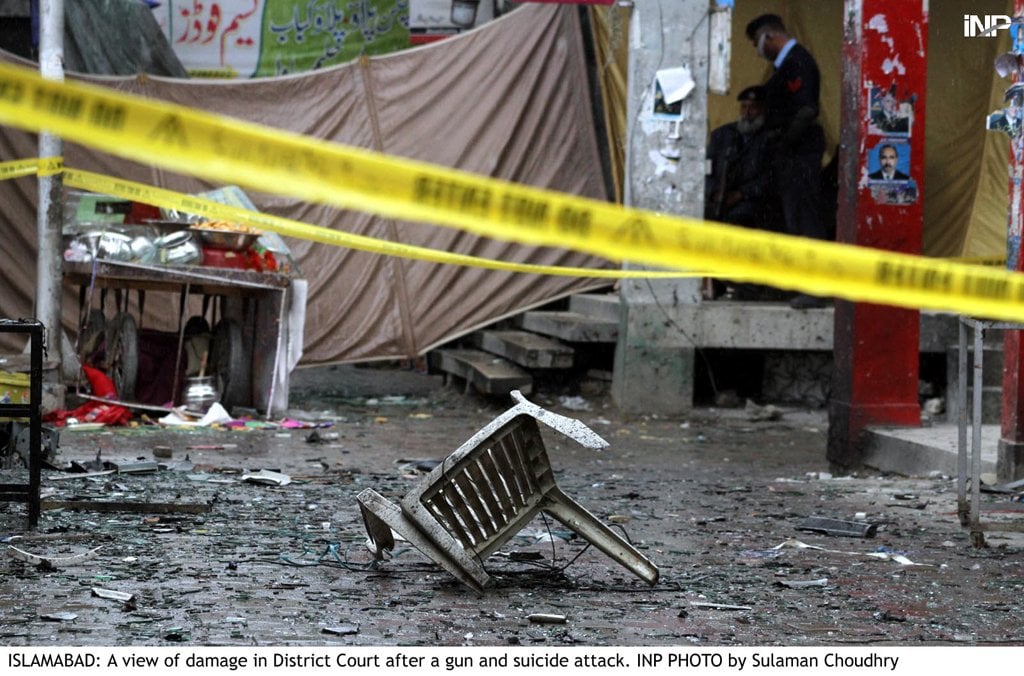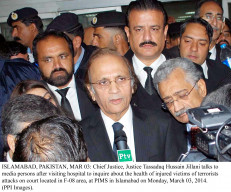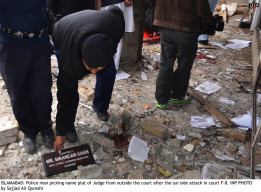
A regular Monday morning at the Islamabad district courts turned into a scene of death and destruction when two suicide bombers and their armed accomplices attacked the compound, killing 11 people, including an additional sessions judge, and injuring over two dozen others.
By noon, the labyrinthine and congested compound of the district courts in Sector F-8 echoed with a silence that only death can master.
Police put the number of attackers at three to four. They entered the district courts through an entrance in the back. Later in the day, it transpired that the attackers belonged to a little-known militant group called Ahrarul Hind.
“We claim responsibility for the attack,” a purported spokesman for the group told The Express Tribune by phone from somewhere in Afghanistan.
The spokesman, who said he was speaking on behalf of the group’s leader Umer Mansoor, opposed the ongoing peace dialogue. “We do not favour the ceasefire and peace talks as it is un-Islamic,” he added. “Our main demand is implementation of Sharia [law] and it has not been mentioned in the talks.”
The court compound, a poorly guarded area with defunct body scanners and over 20 side street entrances, had around 50 policemen on security duty at the time of the attack, according to police officials.
None could effectively neutralise the attackers, who the police said were in their mid-20s, wore short beards and khaki shalwar kameez.
“Three gunmen opened fire as soon as they entered the area,” Interior Minister Chaudhry Nisar Ali Khan said.
Eyewitnesses, most of whom put the number of attackers between four and seven, said they started firing near the courts of civil judges Naveed Khan and Azhar Nadeem, who also sustained injuries.
“The firing lasted for around 15 minutes,” SSP Operations Muhammad Rizwan told The Express Tribune. During this time, eyewitnesses said the gunmen ‘roamed freely’ through the narrow streets lined with lawyers’ chambers, firing at will.
Lawyers said the death toll could have been higher if a hand grenade hurled by one of the attackers into the Waqar Gillani hall, a cafeteria-like area where lawyers huddle in the morning, had actually exploded. Some eyewitnesses said the attackers were only targeting government servants and lawyers and told other civilians to leave the premises. There was also speculation about the kind of cases that a judge killed in the attack was hearing or had heard in the past to fix the motive.
But police said it was ‘definitely a terrorist attack’ and an initial investigation report submitted to the interior ministry by security agencies stated “the attackers had no specific target”.
Medics said 29 people were injured in the attack – three of them critically.
The dead included people who were in court for hearings, a police constable, lawyers and Additional Sessions Judge Rafaqat Awan.
Awan was hunted down in a chamber inside his court by one of the gunmen, according to Muhammad Banaras, a Munshi at the district courts. “The gunman shot straight at the judge,” he said.
Awan was known for rejecting a petition by the Shuhada Foundation seeking registration of FIR against former military ruler Pervez Musharraf for the 2007 Lal Masjid operation.
The attackers used hand grenades, automatic rifles and suicide vests during the attack, Rizwan said. IGP Sikandar Hayat confirmed that two suicide bombers blew themselves up at separate locations inside the compound.
The worst hit was Block number 3, where the attacker who had shot Awan exploded after being hit in a fire exchange with an Anti-Terrorist Squad officer. The block included Awan’s court and the courts of two additional sessions judges Muhammd Adnan and Sikandar Khan, who escaped in time before the blast.
Their courtrooms, however, were destroyed in the blast.
Shattered white-tinted glass littered the floor of the alley in front of the courts. Inside the rooms, furniture and file cabinets were smashed violently against each other. Throughout the compound, there were bullet holes staring back from windows and blood stains and tiny bits of flesh strewn on the streets.
The second bomber blew himself up a few blocks to the south of Awan’s court, causing a crater. Police found the head and legs of one of the bombers. Intelligence sources claimed one gunman, wearing a red sweater, escaped.
Police were conducting search operations in the twin cities to find him but no arrests were made till the filing of this report. The capital was put on high security alert and security was beefed in the city’s sensitive Red Zone.
Monday’s suicide blasts were the first in Islamabad since the 2011 suicide attack outside a private bank. A suicide bomber tried to blow himself up at a mosque in Bara Kahu in August 2013 but his vest malfunctioned and he was killed by a security guard.
Published in The Express Tribune, March 4th, 2014.










































COMMENTS
Comments are moderated and generally will be posted if they are on-topic and not abusive.
For more information, please see our Comments FAQ